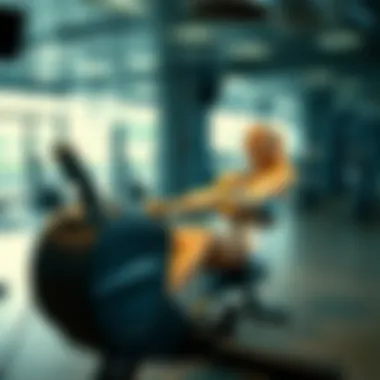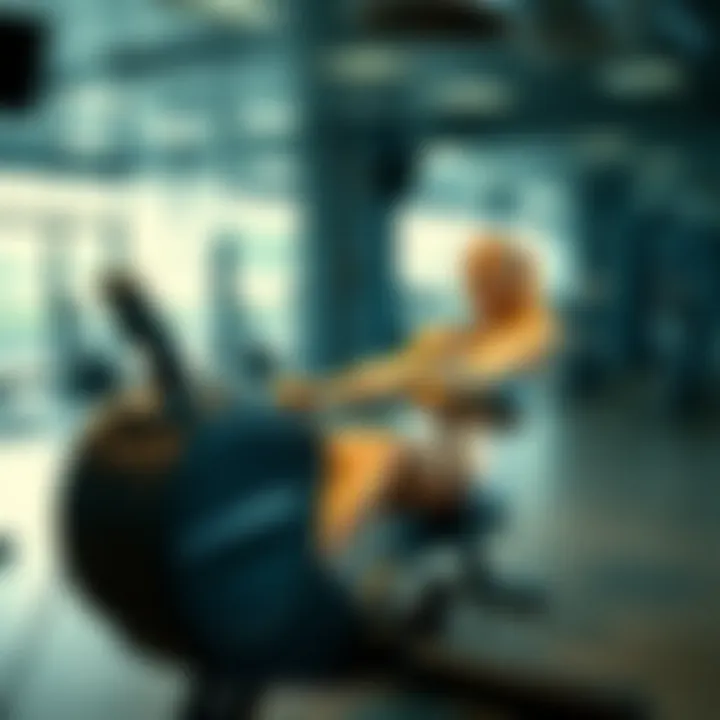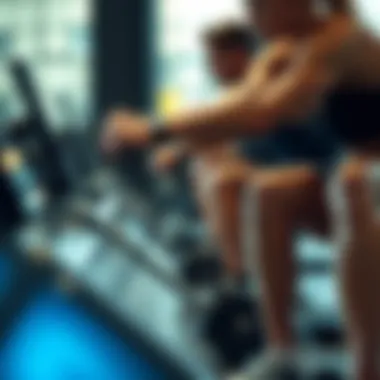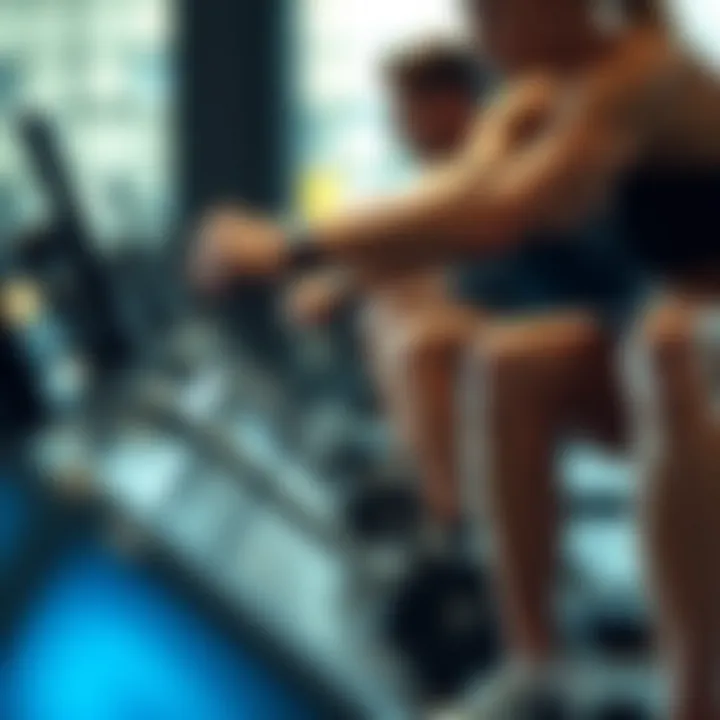Maximize Weight Loss with Rowing Machine Workouts


Intro
The pursuit of weight loss and better health often leads individuals to consider various forms of exercise. Among these, the rowing machine stands out as a uniquely effective tool for achieving fitness goals. Not only does it offer a full-body workout, but it also appeals to those looking to burn calories while improving cardiovascular health. Delving into the mechanics of rowing reveals how it can engage multiple muscles simultaneously, enhancing overall strength and endurance.
The journey of integrating a rowing machine into a fitness routine is both rewarding and enlightening. It opens the door to understanding not just the physical exertion, but also the techniques essential for maximizing benefits. The rhythmic, repetitive nature of rowing may appear straightforward, yet it harbors intricacies that can make or break a workout session.
As we explore the finer details, it becomes evident that mastering the rowing machine is a journey that factors in many elements, from proper form to nutrition. This article aims to equip health professionals, wellness coaches, nutritionists, fitness trainers, and mindfulness instructors with the knowledge needed to guide others—or themselves—toward effective weight loss through the rowing machine.
With that foundation laid, let’s dive into the wellness insights that provide context to our focus on rowing.
Understanding the Rowing Machine
In the realm of fitness equipment, the rowing machine stands out as a remarkably effective tool for those seeking to lose weight and improve overall fitness. It combines both aerobic exercise and strength training, which is a rare feat in physical training. Understanding how this machine works, the types available, and their specific advantages is crucial for anyone looking to integrate rowing into their weight loss strategy.
The rowing machine operates on the principle of mimicking the action of rowing a boat. While this seems straightforward, the mechanics involve multiple muscle groups, which in turn promotes fat burning and muscle building. As you engage different parts of your body, you not only enhance endurance but also work on your strength, aiding in a more well-rounded fitness regimen. The beauty of rowing machines lies in their adaptability, making them suitable for beginners and seasoned athletes alike.
> A rowing machine offers the opportunity to engage in a full-body workout without putting undue stress on the joints.
The Mechanics of Rowing
Rowing combines technique, rhythm, and timing. A successful stroke consists of multiple parts: the catch, drive, finish, and recovery. Each phase has a specific role in maximizing efficiency and ensuring that you’re using the right muscles. Therefore, understanding these mechanics aids in improving both performance and safety.
When you initiate a stroke, the catch phase requires your body to be flexible and aligned properly. The drive phase is where the magic happens—pressing against the footplate utilizing your legs while your arms pull the handle. This phase engages your major muscles, not just in your legs but also in your core and back. The finish is where you complete the stroke while keeping your posture, and in recovery, you smoothly return for the next stroke, maintaining control and avoiding injury.
Types of Rowing Machines
Choosing the right rowing machine can significantly impact your experience and results. Different machines cater to varying fitness levels and preferences, each with its nuances. Here’s a closer look at four primary categories of rowing machines:
Air Rowers
Air rowers use a flywheel to create resistance. The harder you pull, the more resistance you encounter. This means you can tailor your workout intensity just by how aggressively you row. One significant aspect is their larger fan that allows for a smoother, more realistic rowing feel, akin to being on the water. They are particularly favored by those training for competitive rowing or those seeking high-intensity workouts. However, they can be noisy, which might be a consideration if you're in a shared space.
Magnetic Rowers
Magnetic rowers use magnets to create resistance. They offer a quieter workout, making them excellent for home use. They allow for gradual increases in resistance, so you can ramp up your workouts without jerking movements. Another key advantage is that they usually come with a variety of resistance levels, offering flexibility for both beginners and advanced users. On the downside, some may find the experience less engaging because it lacks the natural feel of air or water rowers.
Water Rowers
Water rowers provide a unique experience by using water to create resistance, mimicking the experience of rowing on a lake or river. They offer an appealing aesthetic, often crafted from wood, and give a soothing sound of sloshing water with each stroke. This type appeals to those seeking a more immersive experience and a smooth rowing motion. It’s worth noting though, the maintenance required to deal with the water levels and cleanliness can be a downside for some users.
Hydraulic Rowers
Hydraulic rowers are often more affordable and compact, making them a good option for those with limited space. They use pistons to create resistance and usually offer a strong workout without requiring extensive load levels. However, they typically target fewer muscle groups compared to other types and may not provide the same full-body engagement. Still, for individuals starting their fitness journey or looking for an effective solution to enhance cardiorespiratory fitness, they can prove invaluable.
Benefits of Rowing for Weight Loss
Rowing provides a trifecta of benefits for weight loss: it’s calorie-burning, strengthens muscles, and improves cardiovascular health. Engaging in rowing can allow a person to burn more calories per minute compared to some other forms of cardio. With a mix of resistance training and aerobic components, it sets the stage for effective fat loss. Furthermore, the reliance on core strength makes it an excellent choice for improving overall stability, making daily activities easier as you progress.
Ultimately, grasping the workings of the rowing machine, the various types available, and the benefits of rowing will arm you with the knowledge necessary to embark on or enhance your weight loss journey.
Setting Realistic Weight Loss Goals
Setting realistic weight loss goals is crucial in the journey of effective weight loss, particularly when incorporating the rowing machine into your routine. Having a clear roadmap can prevent frustration and enhance motivation along the way. Many individuals jump into fitness with high expectations, expecting rapid changes. However, this can lead to disillusionment if those expectations aren’t met.
When you establish realistic goals, you set yourself up for success rather than disappointment. It allows you to track progress, appreciate small victories, and maintain a healthier mindset about weight loss. Goals that are too ambitious might push you too hard, leading to burnout or injury. In contrast, attainable goals can foster success that feels rewarding and encourages you to stick with your program.
Establishing a Baseline
To begin with, you need a baseline. This means understanding where you're starting from before diving headfirst into a rowing program for weight loss. This includes weighing yourself, noting measurements around your waist, hips, and perhaps other key areas. Keeping a record of these details can help frame your perspective.
Moreover, it's helpful to assess your fitness level. Are you new to exercise? Or have you been rowing for a while? Knowing your background assists in tailoring your rowing workouts effectively. You can also gauge your current energy levels and stamina. Remember, it's all about knowing where you stand, as this sets the foundation to build upon.
Understanding Body Composition
The next piece of the puzzle is body composition. Just looking at the number on the scale doesn't paint the full picture. Instead, think about the proportion of muscle, fat, and other tissues in your body. Gaining muscle while losing fat can sometimes result in the scale moving less than expected.


A healthier lifestyle can lead to changes that are subtle in weight but significant in health. Consider using methods like skinfold measurements or body fat calculators to get a clearer understanding of your body composition. Knowing your body’s makeup can give you a more precise idea of realistic weight loss goals.
Calculating Caloric Deficit
One of the most important concepts in weight loss is the caloric deficit. This means consuming fewer calories than your body expends. Rowing can burn a fair number of calories, but it's essential to know how many you need to consume to achieve your goals.
To get an accurate picture:
- Calculate your Total Daily Energy Expenditure (TDEE): This calculates all the calories you burn in a day, considering both activity and resting. Online calculators can assist with this.
- Set a caloric goal: A common guideline is to aim for a deficit of about 500 calories per day for a steady weight loss of roughly 1 pound per week. However, this number should be adjusted according to individual needs.
- Monitor your intake: Consider using apps or a journal to track what you eat. It’s all too easy to lose sight of actual consumption amidst busy schedules.
Further recalibrating your calorie goals each week or month can help stay on track. As you incorporate regular rowing and adjust your nutrition, keeping this continuous evaluation will allow a better grip on the journey toward those weight loss objectives.
Beginner's Rowing Technique
The rowing machine can be an excellent tool for beginners looking to dive into the world of fitness and weight loss. It's not just about leaning back and pulling on the handle; there's a method to the madness that, if followed, can enhance the effectiveness of the workout and prevent unnecessary strain. Understanding proper technique not only boosts performance but also keeps you injury-free and ensures you're making the most out of your rowing session. This section breaks down the essentials of beginner's technique into fundamental elements that can shape your rowing journey.
Posture and Setup
Setting yourself up correctly on the rowing machine is akin to laying the foundation of a house. If it's not solid, everything built on top of it will likely falter. Begin by adjusting the seat and foot straps. Your feet should fit snugly in the straps, with your knees slightly bent when seated. You want your back straight and your core engaged, almost like a beam of wood standing tall. Leaning too far forward or backward can throw off your center of gravity, leading to inefficiency and fatigue.
In rowing, keeping a neutral spine is crucial. Think of someone gently pulling your head up; it helps prevent slouching. Your shoulders should be relaxed, with your elbows close to your body. This posture does not only support the arms in pulling but encourages a fluid movement. By ensuring a solid setup, beginners can prevent discomfort and move seamlessly into more advanced techniques.
The Four Phases of a Stroke
This section shines a light on the four phases of the rowing stroke, which play a vital role in crafting a smooth and effective rowing experience. Each phase holds its unique characteristics that contribute to both efficiency and power in rowing.
Catch
The catch is where it all begins—the initial part of the stroke when you are at the front of the machine, ready to push off. This is when your legs are extended, and your hands grasp the handle. The key characteristic of the catch is positioning; it's critical to set yourself up with your shins vertical and your core braced. If done right, it sets the stage for a powerful drive.
The catch is, in many respects, a beneficial starting point. It resembles loading a spring: as you compress your body forward, you're preparing energy for a powerful output in the next phase. The unique feature here is that proper execution at the catch can significantly reduce the strain placed on your back, a common issue for many beginners. Making a point of practicing this phase can prevent serious injuries down the line.
Drive
Once you complete the catch, the drive phase is where the magic happens. At this stage, you push back using your legs first, engaging your core and then pulling with your arms—this sequence is the essence of efficient rowing. A good drive unleashes the power you've built up in the catch phase.
The drive is defined by its fluidity and force; it’s what transforms energy into momentum. With beginners, it’s crucial to stress that rushing this phase can lead to losses in power. The unique feature here is that each part of the body works synergistically. If you push with your legs but neglect your arms too soon, you're not maximizing your effort.
Finish
The finish is the culmination of all your hard work—where the stroke completes and you bring the oar back to your body. Your legs should be straight, arms extended, and back straight. A well-executed finish signifies that you've effectively used your energy throughout the stroke.
The key characteristic of the finish is control; it might seem tempting to slump back in relief, but maintaining postural integrity is essential. This phase is beneficial for muscle engagement, reinforcing the upper body strength and core stability that develops over time. An often-overlook feature is how engaging your core in the finish can enhance overall muscle tone—vital for those on a weight loss journey.
Recovery
As the name suggests, the recovery phase allows your body to reset. After the finish, you glide forward again to your starting position—the catch. This phase is all about relaxation and control; you need to let your body move in a fluid way to prepare for the next stroke.
This phase’s key characteristic is its rhythm. It hinges on slow, deliberate movements, preventing interruptions in your flow. The unique feature of recovery lies in how it allows muscles to engage actively and rest at the same time, striking a balance that's crucial for endurance. For beginners, understanding the recovery phase means recognizing the importance of rest within the workout. A common mistake is rushing this part, leading to poor form in subsequent strokes.
Common Mistakes to Avoid
Becoming proficient in rowing means being adept at not just executing the strokes but also understanding what to sidestep. Beginners often fall prey to mistakes that can diminish their workout effectiveness. Here are some pitfalls to watch:
- Inappropriate Posture: Slumping can lead to discomfort and injury. Maintain that straight back and engaged core.
- Rushing the Drive Phase: Each phase should flow into the next. Take your time to get the sequence right.
- Neglecting the Recovery Phase: Many jump right back into another stroke, which can lead to burnout.
- Fidgeting with Feet: Ensure your feet are consistently strapped in; an improper fit can cause instability.
Creating a Rowing Workout Plan
Designing a rowing workout plan is a critical piece of the puzzle in anyone's weight loss journey. A well-structured plan keeps you on track, motivates you to hit those sessions regularly and offers variety to meet both physical and mental needs. Creating a routine isn't just about setting a schedule; it's an opportunity to meld different techniques that amplify your rowing experience and increase caloric expenditure. This plan should consider both the frequency of workouts and the intensity of different sessions to keep it challenging and engaging.
Determining Workout Frequency
Determining how often you should row is like figuring out the right dose of a medicine—it has to be tailored to you. For beginners, starting with three to four sessions per week can help you ease into the ropes without risking burnout or injury. For those who are more seasoned in fitness or have a higher base level of endurance, increasing this to five to six times weekly can really ramp up results.
- Your schedule and commitments play a big role. You don't wanna bite off more than you can chew! Being realistic about your available time ensures that you stick to your plan.
- Always remember to listen to your body. If fatigue or soreness sets in, it’s perfectly okay to take an extra rest day. Achieving consistency is the key here.
Incorporating Intervals


Interval training is another golden nugget that can maximize your efforts on the rowing machine. This technique involves alternating between high-intensity and lower-intensity rowing, which can spike your caloric burn significantly. Just to put it starkly, interval training has been shown to enhance metabolism for hours after your workout—that’s the kind of bang for your buck we’re all looking for.
"High-intensity intervals can increase post-exercise energy expenditure more than steady-state rowing!"
To get started:
- Warm up for about 10 minutes to prepare your muscles.
- Follow this with 1 minute of all-out rowing—give it everything you’ve got!
- Then transition to 2 minutes of slow-paced rowing to catch your breath.
- Repeat this cycle for 20-30 minutes.
- Cool down afterwards to aid recovery.
Mixing Rowing with Other Workouts
Incorporating a variety of exercises is akin to seasoning food; it keeps your workouts flavorful and enjoyable. Here are two effective categories you can seamlessly blend with your rowing routine:
Strength Training
Strength training has a special role in crafting a holistic fitness routine. By integrating strength workouts, you not only enhance muscle tone but also support weight loss through improved metabolism. It’s like having a secret weapon in your back pocket! Incorporate compound movements like squats and deadlifts that work multiple muscle groups simultaneously—this can help hone in on both strength and endurance.
Unique Feature of Strength Training: It builds lean muscle mass, which enhances your resting metabolic rate. That means, even when you’re not working out, your body burns more calories.
Endurance Activities
Endurance activities such as running or cycling can complement your rowing sessions well. They build aerobic capacity, which in turn can help sustain longer rowing sessions with better efficiency. As a bonus, these activities help break the monotony of a single-exercise focus.
Unique Feature of Endurance Activities: They promote cardiovascular fitness, making daily activities feel easier while enhancing row performance over time. A well-rounded approach to fitness naturally decreases the risk of injury and overtraining.
By considering these various elements, you can create a rowing workout plan that keeps you stimulated and progressing. The mix allows you to tackle your fitness goals more effectively and sustainably, all while enjoying the journey.
Nutritional Considerations for Weight Loss
When it comes to weight loss, nutrition is often the unsung hero. It’s more than just calories in versus calories out; it’s about the quality of those calories and how they fuel your body, especially when you’re working hard on a rowing machine. The rowing exercise not only utilizes substantial energy but also demands a well-rounded nutritional approach that can significantly enhance performance, recovery, and overall results. This section discusses the vital aspects of pre-workout nutrition, post-workout recovery meals, and hydration strategies.
Pre-Workout Nutrition
Before you dive into a rowing session, what you eat can make a world of difference. Think of it as putting premium fuel in your car. Consuming the right nutrients prepares your body for the demands of rowing. Focus on these elements:
- Carbohydrates: They provide quick energy. Foods like oatmeal or a banana can kickstart your session.
- Protein: A small serving can help in muscle repair. Consider a scoop of Greek yogurt or a handful of nuts.
- Timing: Aim to eat about 30 to 60 minutes before rowing. This time frame allows your body to digest and utilize the energy effectively.
Remember, don’t overdo it. Too much food too close to your workout may cause discomfort as you pull those oars.
Post-Workout Recovery Meals
Replenishing your body after a workout is as crucial as the warm-up. This is when your muscles are primed to absorb nutrients. Here are some noteworthy considerations:
- Protein-Rich Foods: They help in muscle recovery. Grilled chicken with quinoa or a protein shake can be effective.
- Healthy Fats: Incorporating a source of healthy fats can boost recovery. Think avocados or nuts as part of your meal.
- Combining Nutrients: Pair proteins with carbohydrates to replenish glycogen faster. For instance, a smoothie with fruits and protein powder does wonders.
It’s often said, "You’re only as strong as your recovery."
Hydration Strategies
Staying hydrated is key to maintaining peak performance. Rowing can quickly lead to fluid loss, so pay attention to your hydration strategies. Here’s what to keep in mind:
- Water Intake: Aim for about 17-20 ounces of water before exercise and continue to sip during and after. Thirst is a sign; don't wait until you're parched.
- Electrolytes: For longer or intense sessions, consider a drink that contains electrolytes. Coconut water or sports drinks can help balance those depleted electrolytes.
- Daily Routine: Make hydration part of your daily routine, not just workout days. Keeping a water bottle handy is a simple yet effective tactic.
"Good hydration habits build a solid foundation for any fitness journey."
In summary, nourishing your body properly before and after your rowing workouts, combined with smart hydration strategies, can drastically improve your weight loss journey. It’s about fostering a holistic approach that complements your physical efforts on the rowing machine.
Monitoring Progress
In the journey of utilization of a rowing machine for weight loss, monitoring progress holds a pivotal role. It’s not merely about the sweat and calories burned; understanding how your body responds to training can make all the difference. Effective weight loss is a marathon, not a sprint. Tracking your progress aids in maintaining motivation and identifying what works or needs a tweak in your regimen. Every little accomplishment can inspire continued effort, and regular assessments help in refining your approach.
Tracking Weight and Measurements
Tracking weight and other body measurements is an obvious first step, yet it is often overlooked in the context of rowing. By recording weight changes weekly, along with measurements of waist, hips, and thighs, individuals can get a comprehensive view of their progress. It’s crucial to remember that weight fluctuations are normal and can be influenced by various factors such as water retention.
- Include a diary of your weights, perhaps graphing it to visualize your journey.
- Consider taking body composition readings, which can be more insightful than weight alone.
- Regularly revisiting these measurements will guide your efforts; it’s about mapping change over time.
These metrics serve not just as records but as key motivators to stay committed.


Using Technology for Feedback
In this modern age, technology can be a game changer for anyone aspiring to lose weight through rowing. Fitness trackers, smartwatches, and specific rowing apps can provide in-depth feedback on your performance. For instance, devices such as the Concept2 Model D with PM5 monitor allow the tracking of critical metrics like strokes per minute, distance rowed, and split times. These figures can help in adjusting the intensity and duration of your workouts effectively.
- Wearables and apps can analyze heart rate, personalize workouts, and give reminders for consistency.
- Sharing your progress on platforms like Reddit or Facebook groups for rowing enthusiasts can cultivate a supportive community, adding an extra layer of accountability.
By leveraging these technological tools, the rowing experience becomes more sophisticated and tailored to individual needs, helping pinpoint areas of improvement and kickstarting further motivation.
Adjusting Your Routine as Needed
No routine should be set in stone. An effective rowing program must be adaptable to personal progress and evolving goals. If your weight loss plateaus, recognize that it might be time for a change; altering the intensity or duration of your rowing workouts might break through the barrier. It’s essential to remain flexible and open to new strategies.
- Regular reviews of workout frequency can help in balancing recovery periods with intensity.
- Listen to your body; fatigue or stress might indicate a need for lighter sessions or complementary activities like strength training.
- Evaluate your dietary habits concurrently; sometimes, introducing new nutritional choices can also yield remarkable results in your rowing journey.
"Your best workout is the one you haven't done yet."
Incorporating these insights will empower you to stay on track with your rowing regimen and weight loss goals, ensuring that you are not just rowing, but rowing effectively towards a healthier you.
Potential Challenges and Solutions
Using a rowing machine can be a fantastic way to achieve weight loss goals and improve overall fitness. However, several potential challenges may arise that could complicate the journey. Recognizing these hurdles and addressing them can make the difference between success and stagnation.
Staying Motivated
Staying motivated while on a weight loss journey can sometimes feel like chasing your own tail. It is important to acknowledge that motivation can wax and wane. To combat this, setting clear, obtainable goals is crucial. Instead of aiming solely for a specific weight, think about wanting to complete a set number of workouts per week or mastering your rowing technique.
Additionally, surrounding yourself with a supportive community can bolster your enthusiasm. Joining a local rowing club or engaging with online forums, such as those found on reddit.com, can provide that extra nudge. Remember, celebrating small victories can keep the flame of motivation alive. Perhaps share your milestones on social media or even DIY a vision board that aligns your goals with visual prompts.
Avoiding Overtraining
Striking a balance between pushing hard and resting is akin to walking a tightrope. Overtraining can lead to burnout, fatigue, and injuries, which nobody wants. It’s essential to establish a balanced rowing routine. Aim for a mixture of workouts that includes intense rowing sessions interspersed with lighter, recovery days. By doing so, the body can repair itself and gain strength. Moreover, keeping an eye on your body’s signals is critical. If fatigue, soreness, or irritability creeps in, it might be time to dial back. Listening to your body can aid in avoiding this pitfall.
Here’s some food for thought: consider tracking not just your performance in the gym but also your overall energy levels. This way, you can align your workouts with how you feel over time.
Injury Prevention Techniques
Injuries can derail your weight loss goals faster than you can say 'row, row, row your boat.' Thus, incorporating injury prevention strategies is paramount. One effective way to prevent injury is to focus on proper form during exercises. Ensure that you utilize techniques learned during beginner sessions, especially focusing on posture and the stages of the rowing stroke.
Other injury prevention tips include:
- Warm-up Routine: Always begin with dynamic stretches and light rowing before diving into intense workouts.
- Vary Your Strokes: Mixing up your rowing techniques helps prevent overuse injuries.
- Strength Training: Complement your rowing workouts with strength exercises that target the core and back, which are crucial for supporting rowing movements.
Incorporating these practices can help minimize risk and ensure that your journey on the rowing machine remains productive and enjoyable.
By embracing challenges while also actively seeking solutions, you create a resilient mindset that enhances your weight loss journey on the rowing machine.
For additional resources, check out CDC’s guidelines on exercise or learn more on Britannica’s health section.
Concluding this section, remember that while challenges may arise, they can be met with thoughtful strategies, leading to a more fruitful and sustainable fitness journey.
With the right mindset and approach, the rowing machine can become not just a tool, but a significant ally in achieving long-term weight loss.
The Long-Term Benefits of Rowing
Utilizing a rowing machine doesn't just help in shedding pounds; it lays the foundation for overall health and well-being in the long run. This section will delve into the lasting advantages that come with regular rowing, going beyond the scale to touch on essential facets of fitness, endurance, and mental harmony. With consistency, rowing can significantly elevate your health profile, making it a worthy addition to anyone's fitness plan.
Improved Cardiovascular Health
When it comes to heart health, rowing can be a formidable ally. The rhythmic, full-body motion supports increased heart rate, improving circulation and oxygen transport within the body. Regular sessions on the rowing machine can strengthen your heart muscle, enhance lung capacity, and regulate blood pressure—essentially upping your cardiovascular game.
- Aerobic Conditioning: This is where rowing shines. A sustained rowing workout sharpens your body's oxygen uptake, conditioning the heart to operate more efficiently. And it's not just about pumping iron; a healthy cardiovascular system can lower risks of heart disease, stroke, and other chronic ailments.
- Sustainability: Rowing is a low-impact exercise, which makes it easy on the joints while still delivering a heart-healthy workout. Unlike running or high-impact sports, rowing allows prolonged sessions without the wear and tear on your body, making it a sustainable choice for life.
"Developing a strong cardiovascular system through rowing is like leveling up your internal engine, better equipping your body for the daily demands of life."
Muscle Tone and Endurance Development
Another significant perk of rowing is its ability to sculpt and tone muscles throughout the body. It's like hitting several birds with one stone by targeting multiple muscle groups simultaneously.
- Full-Body Workout: Unlike some exercise forms that focus on isolated muscle groups, rowing engages major muscle areas: legs, back, arms, and core. This not only leads to balanced muscle development but also assists in higher calorie expenditure.
- Endurance Building: Through consistent training, rowing enhances muscular endurance. More than just strength, this is about conditioning your muscles to perform efficiently over extended periods. Long sessions on the machine can improve your stamina in other physical pursuits too, whether that’s cycling, swimming, or even hiking.
Boosted Mental Well-Being
Mental health may not always be at the forefront of fitness discussions, but it’s arguably one of the most valuable benefits of rowing. The meditative aspect of the rhythmical motion can reduce stress and elevate mood.
- Stress Relief: Rowing, with its repetitive and smooth movements, provides a form of active meditation. This can drastically lower cortisol levels, the hormone primarily responsible for stress, leaving you feeling centered and refreshed.
- Enhanced Cognitive Function: There’s growing evidence suggesting that aerobic exercises, such as rowing, can spur neurogenesis—the growth of new brain cells. This enhances both memory and overall cognitive function, providing benefits that extend beyond the gym.



